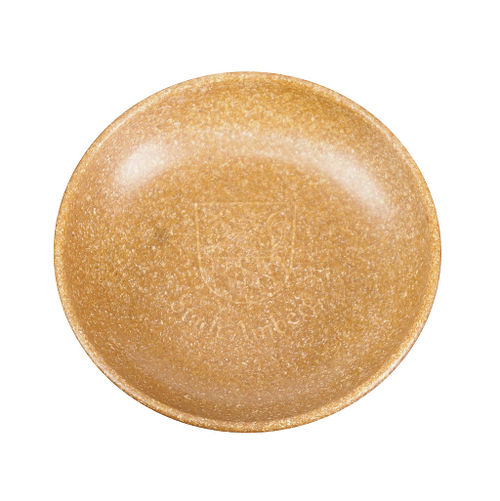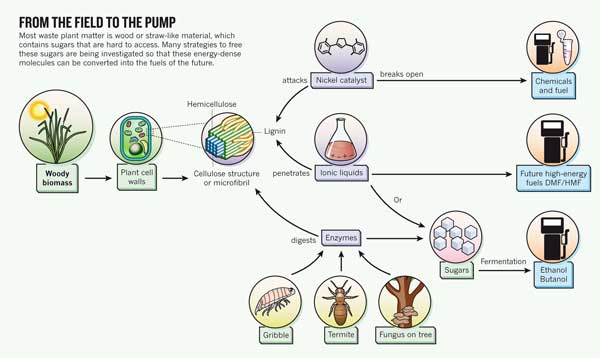Bioplastics
Main > Materials > Bioplastics
Introduction
Bioplastics are the perfect addition to an integrated farm and forestry operation. An effective open-source method of producing bioplastics will allow communities to be self-sufficient in the raw materials for many modern comforts. Bioplastics promise to replace the many useful products we currently extract from oil.
Combined with plastic extrusion and molding machines such as RepRap, bioplastics enable a local manufacturing process that starts with food waste or soil and creates computer and phone casings, car and machine parts, toys and tools, screws and sculptures.
Bioplastics of interest
- Cellophane is reformulated cellulose (wood), produced via an acid and base dunk of sawdust. This may be used in glazing. Car bodies may be made; the original car bodies for Ford were soybean-derived bioplastics.
- Polylactic acid can be made by fermenting starch.
- Polyethylene can be fabricated from ethylene (which can be relatively easily produced from ethanol).
- Mycelium can be placed in a mold with grain husks, wheat straw or any of a wide variety of other biomass (with different end product results) and be made into a variety of useful products, including a durable closed cell foam substitute. See: [1], [2] [3](these refer to the same product and company). According to one patent (Patent application number: 20110306107) suitable fungal species
"include, but are not limited to, Pleurotus djamor, Pleurotus eryngii, Pleurotus ostreatus, Pleurotus ostreatus var. columbines, Grifola frondosa, Ganoderma lucidum, Ganoderma oregonense, Lentinula edodes, Agrocybe aegerita, or Coprinus Comatus" (Read more: [4]).
Work needs to be done open-sourcing this process - what mycelium are used? Where can we get spores? What can we make? We may be able to obtain some and identify it under a microscope (wary of not infringing patents of course; maybe a similar but lower performing mycelium that is not patented could suit our purposes for building insulation etc.)
Where to get
- people of ultimachine.com made their way to natureworks LLC to get PLA (Polylactide), called ingeo (tm)
- makemendel.com offers PLA parts for Mendel since december 2011
- Shenzhen Esun Industrial Co. Ltd. (formerly Shenzhen Brightchina) produces PLA and PCL
- eastern bioplastics, biodegradable plastics from poultry feathers
- FKuR Kunststoff GmbH
- Freitec Kunststoffe GmbH
More readings
Proposed OSE agroecological approach to bioplastic production
This page is meant to organize the information being collected on bioplastic production and proposed project plans. Detailed background and status briefs of individual projects should be maintained on their own page. Information on the advantages and disadvantages of an "anabolic", organic, bioplastic production process and details of the rational design of the overall process should be maintained on this page. Many materials specified in this proposal could be substituted and alternative routes are encouraged and should be given their own page and linked to this page.
Bioplastics come in a variety of forms and will most likely be an important material in the post-scarcity economy. Bioplastics are polymers from a biological source including polyesters, olefins, and other organic chains that can be extruded into a variety of shapes. Plastics have been in production for hundreds of years from both organic sources and petroleum sources. An agroecological approach will utilize local feedstocks to produce refined subunits for polymerization and use life cycle analysis and appropriate technology to maximize efficiency on a small scale. An agroecological approach will build up polymers as opposed to petroleum based methods that start by breaking down materials. By starting with high purity substrates, purification machinery can be minimized and hardware greatly reduced in size. The agroecological route should extract multiple rounds of material from the feedstock which acts to concentrate the remaining substrate. Final waste of unusuable biomass can still be combusted for thermal energy or broken down by mycelium.
Status Brief
An integrated set of bioplastics to fill the necessary OSE product ecologies is currently in the research and development phase. Protocols have been proposed for the production of polyethylene from ethanol and polylactic acid from purified lactic acid and cellulose based bioplastics are currently under development.
Current Challenge
Current challenges are to finish background work on the proposed projects, evaluate their feasibility in an OSE context, and find missing key information for full manufacturing protocols. R&D work must be done to propose strategies for substrate purification in an OSE context and develop the necessary hardware. To expand the OSE chemical engineering and bioplastic production capabilities reactor hardware will have to be purchased or more desirably OS developed and built. The OSE community is asked to contribute uses in specific product ecologies to better focus development.
Systems Engineering Breakdown Diagram
Above is a preliminary Systems Engineering Breakdown Diagram of the bioplastic production process. This can serve as a starting point for analysis of the bioplastics full product ecology.
Plastics of interest
PHA
Polyester - is cultured by bacteria from sugar. - [5]
Polyethylene
See page: OSE wiki
Polylactic acid
Cellulose bioplastics
Moldable Mycelium
Feedstocks
Preferred bioplastic feedstocks are plants high in sugar content that is accessible to fermenting microorganisms.
Sorghum
Sorghum is a feedstock of interest for bioplastic production due to its high productivity in producing sugars that can be fermented to either ethanol or lactic acid. The remaining bagasse contains cellulose which can be extracted after acid steam pretreatment as cellulose acetate. The remaining biomass can be burned for thermal energy or composted. Sorghum is a fairly resilient crop and can be planted on less desirable land.
Corn
Corn is the major feedstock for lactic acid and a large source of ethanol. It has a high but not the highest sugar content.
Woody biomass/sawdust
Woody biomass is the starting material for polycelluloses. Unlocking the secret to breaking down cellulose to glucose will yield a major source of high energy sugars.
Monomeric subunits and microorganismal sources
Microorganisms play a key role in converting initial feedstock material's high energy carbon into lower energy structures with functional groups that can be used for polymerization chemistry (forming chemical bonds).
Ethanol
Ethanol is the alcohol fermentation product of yeast and bacteria. Bioplastic conversion takes place in two steps; first ethanol is dehydrated to double bonded ethylene using a lewis acid and metal doping, preferably AlO3 and titanium TiOH. Ethylene molecules can be linked together with polymerization catalysts, of which the Ziegler-Netta catalysts seem preferable.
Lactic acid
Lactic acid is the product of Lactic Acid Bacteria. Polymerization is a dehydration reaction near thermodynamic equilibrium and can take place in a vacuum or over a tin or nickel catalyst.
Cellulose
Cellulose is made of difficult to separate B,1-4 glycosidic linked glucose and paired with other complex polymers including hemicellulose and lignin. Separating cellulose can be done with steam acid treatment, enzymes, or catalytic microorganisms such as Trichoderma reesei.
Acetic acid
The acetate ion is an important comonomer in polymer chemistry and would allow the production of polyethylene vinyl acetate and cellulose acetate from a local feedstock. Acetic acid is a fermentation product of the anaerobic bacteria Clostridium or Acetobacterium.
Hardware
The GVCS contains the tools necessary to produce a feedstock crop. Hardware necessary for the production of refined monomers and conducting chemical reactions are proposed for inclusion in GVCS III and include a fermentor and fluid bed reactor (FBR).
Fermentor
Fluid Bed Reactor (FBR)
Bioplastic Extruder
Electrodialysis unit
Distillation column
Biolab
Bioplastic Open Source Enterprise
Please see new dedicated page - Bioplastic Open Source Enterprise
Links and Books
- Biomass into Bioplastics review paper - [6]
- Treehugger - The Problem with Bioplastics - [7]
- Soybean Car. Ford's car was not bioplastic, but a phenolic resin strengthened with biofibers - [8]
- Book - Green Plastics, An Introduction to the New Science of Biodegradable Plastics - [9]
- Introduction to Bioplastics Engineering" - [10]
- Bioplastics Home Inventor's Handbook - focuses on polymerizing existing polymers into bioplastics. Not accessible in Linux format. [11]



